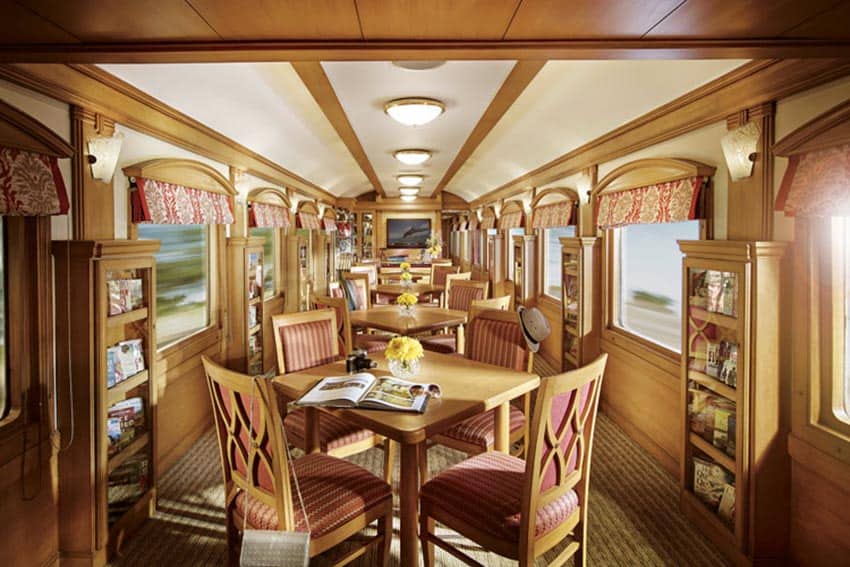Waterfalls and Monasteries Add to Charm in Sikkim
By Mridula Dwivedi

A few months back, I was inviting suggestions and when a colleague talked about a visit to Sikkim in December, I was intrigued but apprehensive at the same time.
He assured me it would not be very cold. But cold can mean different things to different people. When most folks have yet to declare winter, I already start using the room heater.
I can become quite miserable if the weather is too cold, though Sesha’s (my husband) motto is, the colder the better. So, when I sounded him out for Sikkim, he was quite enthusiastic. After searching on the internet (Indiamike, in particular) I concluded that many people have already achieved the feat I was considering and there are high chances of coming back in one single piece.
We took the Dibrugarh Rajdhani Express train from New Delhi to New Jalpaiguri and the idea was to use road transport after that. Road transport in the hills means Avomine (anti-nausea medicine) for us.
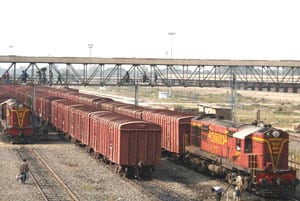
We are not a great fan of big towns so, we wanted to go to Pelling rather than the capital city of Gangtok.
There are no shared jeeps available (at least we could not find them) from New Jalpaiguri railway station to Pelling, though they are available for Gangtok. So, we headed to Siliguri (7-8 km away) and from there, we got a jeep to Pelling (300 rupees, 6 dollars per seat).
It seems to be a standard practice in Indian hills to take two people on the seats meant for one and four on the seats meant for three. It happened in Leh and it happened here again.
We had a total of eleven people including the driver in a jeep meant to take 8-9 people. We were tossed around on the back seats but mercifully the ride was only three and a half hours rather than the eighteen that we faced from Manali to Leh. The roads are quite good in Sikkim as compared to other hill station roads in India.
Due to Avomine, I fell asleep shortly and when we stopped for tea at some Dabha, I refused. The mind now boggles at the possibility that I can actually refuse tea but that is what Avomine does to me.
I took out my mobile phone to switch it off, as I had no hope of getting a signal in the middle of nowhere. But to my surprise, there was a full signal.
Sikkim has amazing network connectivity and I had to struggle really hard to lose it. We don’t consider a holiday complete if we don’t visit places where the mobile gets switched off due to loss of signal.
Pelling (West Sikkim)
It was nearly 8 p.m. when we reached Pelling. It was not really cold here after you discount my use of heavy woolens. As usual, we had not pre-booked a hotel but there were plenty of rooms available in town. We looked at a few and then decided to go with Hotel New Bintan (nothing too distinguishing about it, basic clean rooms and a fabulous view of Khang-Chen-Dzon Ga).
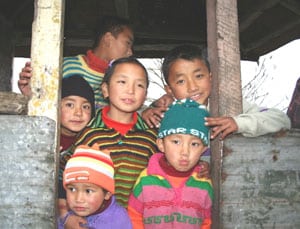
I was really excited to try my new digital SLR and explore the place. But all that had to wait till the next day.
I kept waking up to catch the sunrise (I somehow do not wake up like a dead fish in the hills) and take some pictures of the famous peaks. I saw green hills whenever I would open my eyes but no signs of the snow-capped Khang-Chen-Dzon Ga.
Around 8 a.m. it finally dawned on me to look out of the other window, and there it was, a fabulous view of Khang-Chen-Dzon Ga, in its full glory. The pity is, that the next day it was clouded and I could not photograph the mountain at sunrise.
After breakfast, we were raring to go. There are two monasteries in the area Sangacholing and Pemayangste and we visited both. Sangacholing Monastery can be visited on foot only (but they are building a road) and it is a walk of 2-3 km. The way is marked, though not very clearly, but every second person is willing to provide the directions.

The monastery is a peaceful, picturesque place with lots of prayer flags and small structures surrounding the main complex. The main hall was latched and I merrily opened it and took pictures (there were no signs to the contrary). And then I faced a little music for it.
The caretaker came and told me photography of the hall is prohibited. I apologized and offered to delete the pictures but he let it go. I also said a sign to the same effect would help people like me. He chatted a little while with us and left me feeling a bit less guilty.
There are many eating-places in Pelling and we went into one at random. I had Sikkimise Suija (tea) after lunch. It has salt and butter in it and I must say I like it a lot. Lunch tucked inside, it was time to walk to Pemayangste Monastery.
Jeeps go to Pemayangste but we decided to walk (4-5 km distance from Pelling). There are colorful prayer flags for around half a kilometer on the road leading to the main complex. Pemayangste is bigger than Sangacholing and there are more visitors here.
There are day tours available from Pelling but we gave it a miss at it would involve more Avomine. We had thought to spend the entire vacation in Pelling but after a day we changed our minds and decided to head to Gangtok the next day.
Gangtok
Pelling to Gangtok is three and a half hours by jeep (Rs 150, 3 dollars per ticket). We reached there at mid-day, hungry, tired, zonked and without a hotel booking. In the last week of December, the place was crowded, yet there were some free rooms available. But lunch came before that. We went to The Golden Pagoda on MG road and I would recommend their Rajasthani Thali as excellent (90-95 rupees, roughly 2 dollars for a full meal).

Then we went to a nondescript hotel (Sesha loves them) that I would not recommend to anyone. We immediately hopped out and booked a trip (with the first travel agent we could find) to Yumthang Valley (altitude of 11,800 feet, night stay at Lachung at 8,500 feet) for two days.
I wanted to take the day trip to Nathu-La (India-China border, altitude 14,420 feet) after Yumthang but Sesha did not, too many days of continuous Avomine, he said. We finally decided that I would take the day trip without him in a shared jeep.
Whatever permits were required for both the places were arranged by the travel agent at no extra cost. Though at this time non-Indians can only go up to Changu Lake on the Nathu-La route. By the way, Gangtok feels like a big town and we were glad to use it as a base for other trips.
Yumthang Valley (North Sikkim)
The fun of traveling in a shared jeep is that people turn up at their own time. For Yumthang we were given 10:30 a.m. as the starting time but it was past midday when the jeep finally started moving. We had a short halt at Seven Sisters Waterfall and while it was okay, what really caught my attention was the greenery of North Sikkim.
It feels like a fair place out of JRR Tolkien’s “The Lord of the Rings.” If Elves and Hobbits can exist anywhere, it has to be North Sikkim, in my opinion. North Sikkim was the only place where my mobile connection went down, finally! (Reliance connection) but BSNL connections worked even here at many places.
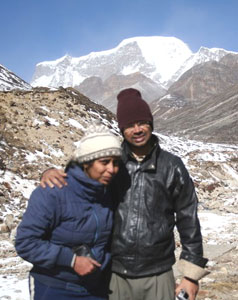
I was glued to the green scenery rolling past me till we reached Lachung at 7 pm. We were put up in a small but clean hotel. At an altitude around 8,500, feet this place was cold.
The package for two days cost us rupees 900 (around 20 dollars) per head and it covered the hotel stay and all the meals (but not tea at the Dhabas or a trip to Zero Point beyond Yumthang).
We were given hot dinner at 10 (the foodstuff travels with us from Gangotk, so there were chickens and vegetables traveling on the roof of the jeep) and we demolished our vegetarian fare with great relish.
The next day we left at 7:30 in the morning for Zero Point and Yumthang. At Zero Point there was snow (not too much under our feet but a lot around us) with a nasty cold wind for company. I walked around and took a lot of pictures but after half an hour I crawled back into the jeep to keep some of the cold and wind out. Soon, others also stumbled in.
On our way back we spent half an hour in the beautiful Yumthang Valley (the Valley of Flowers). Our jeep skidded once half a meter or so on the snow and people had to push it back on the road. We returned to Gangtok the same day and reached back safely at 8:00 p.m.
Nathu-La (India-China Border, East Sikkim)
India fought a battle with China at Nathu-La in 1962 and the pass was closed for more than 40 years, but the ancient silk route was opened for trade in July of 2006.
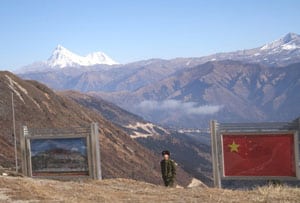
The border is a cheerful place now, teeming with Indian tourists like me. The jeep seat cost me 600 rupees (13 dollars). Our driver Shanker, was careful (another strange thing about Sikkim, 3.5 drivers out of 5, an unusually high number, were not trying to imitate [Formula One racecar driver] Michael Schumaker. 3.5 because one of them did try F1 driving for part of the way) and it took us a little more than three hours to reach Nathu-La.
At many places, Indian army personnel controlled the flow of the traffic. On the way is Changu, a high altitude lake with a small market next to it. We stopped there for a short while. I clicked a few pictures with sun high up in the sky. I thought the light might be better when we came back and I would take more pictures then.
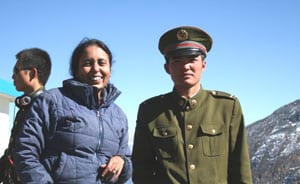
From the car park of Nathu-La it took me just a few minutes (though many people struggle and some find the altitude makes them a little dizzy) to reach the border.
Barbed Wire Border
It is really a barbed wire fence (and apart from that almost every surrounding area is out of bounds) with the curious tourists and our army on one side, and the star attractions, the Chinese soldiers on the other side. They pose readily for the tourists and even pick up kids on their side for a picture.
This exchange of words happens in English. But when I tried to strike a conversation, their faces would go blank, as if they do not understand what I was saying. I am sure it is part of their brief. Looking at the exciting buzz, it is difficult to imagine the amount of tension this border and our relations with China generate.
On our way back, the fog was thick and visibility just a few feet. When Shanker would sprinkle water on the windscreen, it fell down frozen in tiny specs, telling us it was zero degrees outside.
Because of the fog it took us a lot longer to reach back to Changu Lake and even from the side of the road the lake was not really visible. It messed up all my plans of taking better pictures.
- India: Romancing the Chandratal Lake - October 14, 2015
- India: Viewing Tigers Up Close - March 17, 2014
- Kipling’s Bundi: Peacocks and Palaces in Rajasthan - August 13, 2012



